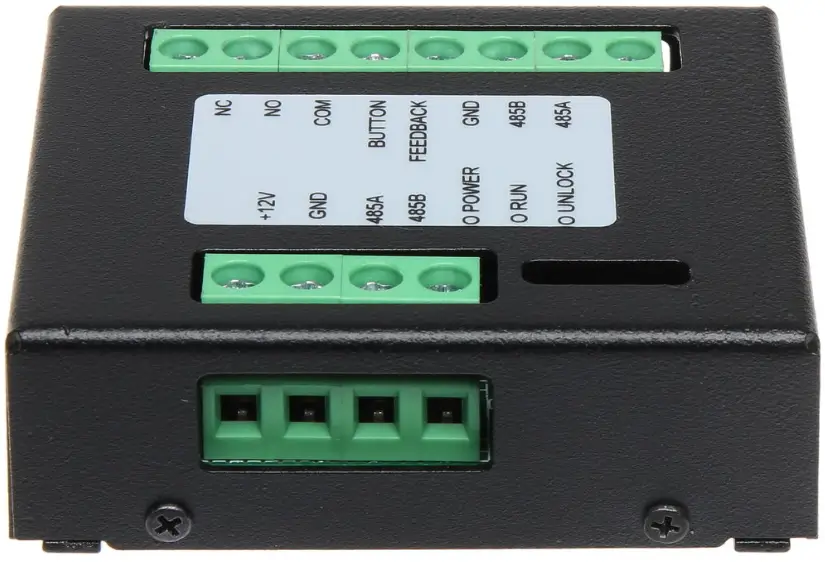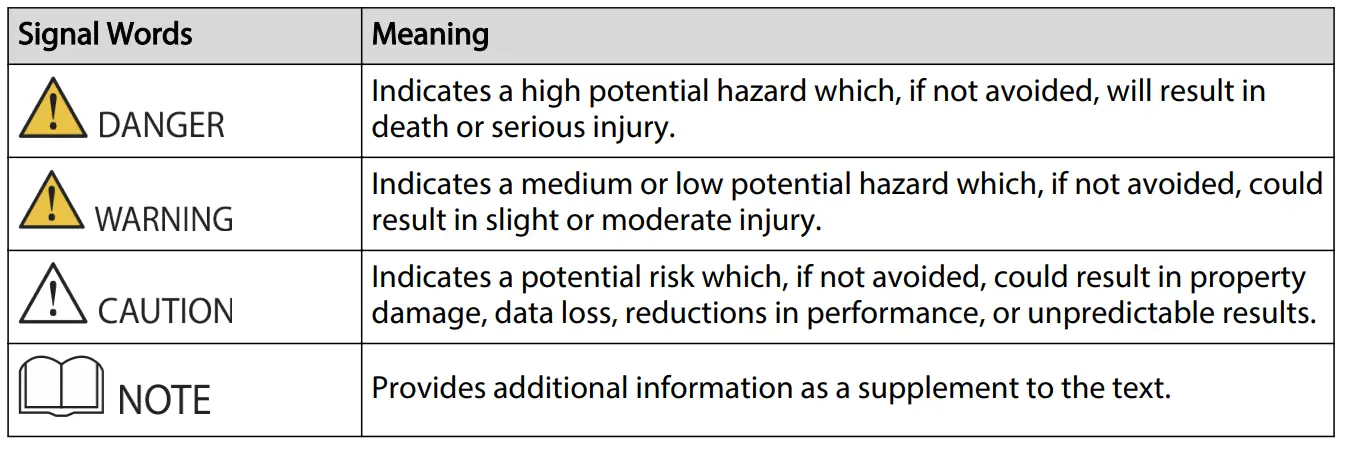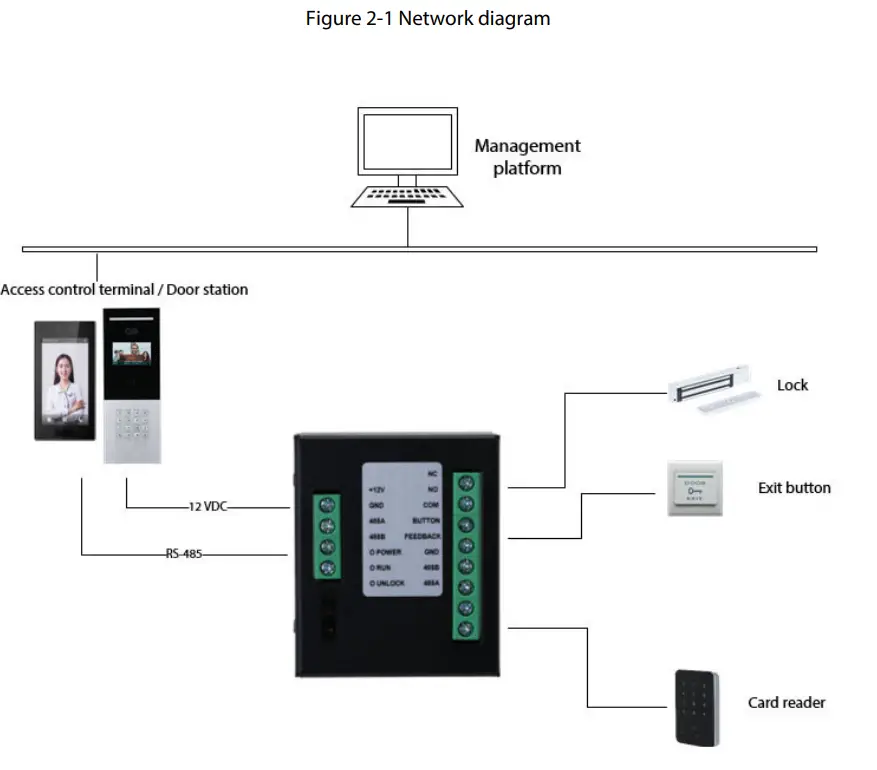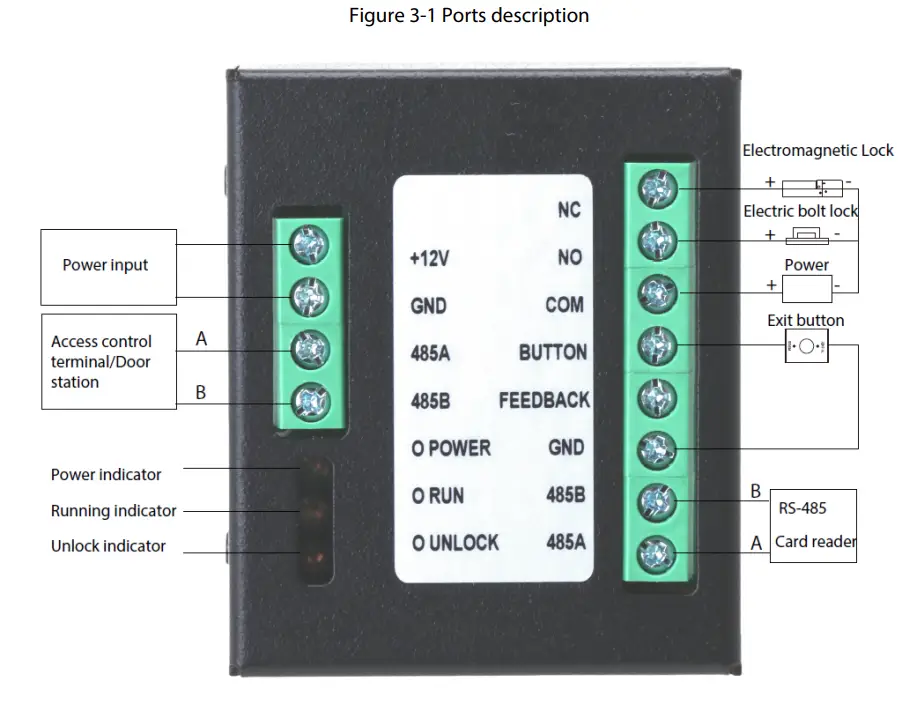MEGATEH DEE1010B Access Control Extension Module

Foreword
General
This manual describes the structure of the device. Read carefully before using the device, and keep the manual safe for future reference.
Safety Instructions
The following signal words might appear in the manual.

Privacy Protection Notice
As the device user or data controller, you might collect the personal data of others such as their face, audio, fingerprints, and license plate number. You need to be in compliance with your local privacy protection laws and regulations to protect the legitimate rights and interests of other people by implementing measures which include but are not limited: Providing clear and visible identification to inform people of the existence of the surveillance area and provide required contact information.
About the Manual
- The manual is for reference only. Slight differences might be found between the manual and the product.
- We are not liable for losses incurred due to operating the product in ways that are not in compliance with the manual.
- The manual will be updated according to the latest laws and regulations of related jurisdictions. For detailed information, see the paper user manual, use our CD-ROM, scan the QR code or visit
- our official website. The manual is for reference only. Slight differences might be found between the electronic version and the paper version.
- All designs and software are subject to change without prior written notice. Product updates might result in some differences appearing between the actual product and the manual. Please contact customer service for the latest program and supplementary documentation.
- There might be errors in the print or deviations in the description of the functions, operations and technical data. If there is any doubt or dispute, we reserve the right of final explanation.
- Upgrade the reader software or try other mainstream reader software if the manual (in PDF format) cannot be opened.
- All trademarks, registered trademarks and company names in the manual are properties of their respective owners.
- Please visit our website, contact the supplier or customer service if any problems occur while using the device.
- If there is any uncertainty or controversy, we reserve the right of final explanation.
Important Safeguards and Warnings
This section introduces content covering the proper handling of the device, hazard prevention, and prevention of property damage. Read carefully before using the device, and comply with the guidelines when using it.
Transportation Requirement
Transport, use and store the device under allowed humidity and temperature conditions.
Storage Requirement
Store the device under allowed humidity and temperature conditions.
Installation Requirements
Warning
- Do not connect the power adapter to the device while the adapter is powered on.
- Strictly comply with the local electric safety code and standards. Make sure the ambient voltage is stable and meets the power supply requirements of the device.
- Do not connect the device to two or more kinds of power supplies, to avoid damage to the device.
- Improper use of the battery might result in a fire or explosion.
- Please follow the electrical requirements to power the device.
Following are the requirements for selecting a power adapter.- The power supply must conform to the requirements of IEC 60950-1 and IEC 62368-1 standards.
- The voltage must meet the SELV (Safety Extra Low Voltage) requirements and not exceed ES-1 standards.
- When the power of the device does not exceed 100 W, the power supply must meet LPS requirements and be no higher than PS2.
We recommend using the power adapter provided with the device.
When selecting the power adapter, the power supply requirements (such as rated voltage) are subject to the device label.
- All the electrical connections must comply with the local electrical safety standards to avoid short circuits and electrical leakage.
- Personnel working at heights must take all necessary measures to ensure personal safety including wearing a helmet and safety belts.
- Do not place the device in a place exposed to sunlight or near heat sources.
- Keep the device away from dampness, dust, and soot.
- Install the device on a stable surface to prevent it from falling.
- Secure the device to ensure its stability and security.
- Install the device in a well-ventilated place, and do not block its ventilation.
- Use an adapter or cabinet power supply provided by the manufacturer.
- Use the power cords that are recommended for the region and conform to the rated power specifications.
- The device is a class I electrical appliance. Make sure that the power supply of the device is connected to a power socket with protective earthing.
- Attach an emergency door opening device to the device or set up measures for emergency power-off to ensure the safety of people in emergency.
Operation Requirements
- Check whether the power supply is correct before use.
- Ground the device to protective ground before you power it on.
- Do not unplug the power cord on the side of the device while the adapter is powered on.
- Operate the device within the rated range of power input and output.
- Use the device under allowed humidity and temperature conditions.
- Do not drop or splash liquid onto the device, and make sure that there is no object filled with liquid on the device to prevent liquid from flowing into it.
- Do not disassemble the device without professional instruction.
- This product is professional equipment.
- The device is not suitable for use in locations where children are likely to be present.
- When using the device in an access control system, ensure that the permissions of the access control system are configured properly to prevent unauthorized entry.
Packing List
Check the items in the packaging box according to the packing list.
Table 1-1 Packling list
| Item | Quantity |
| Access control extension module | 1 |
| User’s manual | 1 |
Introduction
Overview
The Access Control Extension Module can work with the access control terminal or door station. The Extension Module communicates with the access control terminal or door station through RS-485 BUS, and connects with door detector, exit button, card reader and lock. The Extension Module transmits card information, door open information and alarms to the access control terminal or door station, improving the access control security.
Network Diagram
Ports Description

FAQ
- The door cannot open when I swipe card.
- Check the card information on the management platform. Your card might be expired or not authorized, or card swiping is only allowed in the defined time schedules.
- The card is damaged.
- The Extension Module is not properly connected to the card reader.
- The door detector of the device is damaged.
- The Extension Module cannot work properly after networking.
Check whether the security module function is enabled on the webpage of the access control terminal, or check whether the second lock function is enabled on the webpage of the door station. - The door cannot open by the exit button.
Check whether the exit button and the Extension Module are well connected. - The lock remains open for a long time after the door opens.
- Check whether the door is closed.
- Check whether the door detector is well connected. If there is no door detector, check whether the door detector function is turned on.
- There are other problems that remain unsolved.
Ask the technical support for help.
Appendix 1 Security Recommendation
Account Management
- Use complex passwords
Please refer to the following suggestions to set passwords:- The length should not be less than 8 characters;
- Include at least two types of characters: upper and lower case letters, numbers and symbols;
- Do not contain the account name or the account name in reverse order;
- Do not use continuous characters, such as 123, abc, etc.;
- Do not use repeating characters, such as 111, aaa, etc.
- Change passwords periodically
It is recommended to periodically change the device password to reduce the risk of being guessed or cracked. - Allocate accounts and permissions appropriately
Appropriately add users based on service and management requirements and assign minimum permission sets to users. - Enable account lockout function
The account lockout function is enabled by default. You are advised to keep it enabled to protect account security. After multiple failed password attempts, the corresponding account and source IP address will be locked. - Set and update password reset information in a timely manner
The device supports password reset function. To reduce the risk of this function being used by threat actors, if there is any change in the information, please modify it in time. When setting security questions, it is recommended not to use easily guessed answers.
Service Configuration
- Enable HTTPS
It is recommended that you enable HTTPS to access web services through secure channels. - Encrypted transmission of audio and video
If your audio and video data contents are very important or sensitive, it is recommended to use encrypted transmission function in order to reduce the risk of your audio and video data being eavesdropped during transmission. - Turn off non-essential services and use safe mode
If not needed, it is recommended to turn off some services such as SSH, SNMP, SMTP, UPnP, AP hotspot etc., to reduce the attack surfaces. If necessary, it is highly recommended to choose safe modes, including but not limited to the following services:- SNMP: Choose SNMP v3, and set up strong encryption and authentication passwords.
- SMTP: Choose TLS to access mailbox server.
- FTP: Choose SFTP, and set up complex passwords.
- AP hotspot: Choose WPA2-PSK encryption mode, and set up complex passwords.
- Change HTTP and other default service ports
It is recommended that you change the default port of HTTP and other services to any port between 1024 and 65535 to reduce the risk of being guessed by threat actors.
Network Configuration
- Enable Allowlist
It is recommended that you turn on the allowlist function, and only allow IP in the allowlist to access the device. Therefore, please be sure to add your computer IP address and supporting device IP address to the allowlist. - MAC address binding It is recommended that you bind the IP address of the gateway to the MAC address on the device to reduce the risk of ARP spoofing.
- Build a secure network environment In order to better ensure the security of devices and reduce potential cyber risks, the following are recommended:
- Disable the port mapping function of the router to avoid direct access to the intranet devices from external network.
- According to the actual network needs, partition the network: if there is no communication demand between the two subnets, it is recommended to use VLAN, gateway and other methods to partition the network to achieve network isolation;
- Stablish 802.1x access authentication system to reduce the risk of illegal terminal access to the private network.
Security Auditing
- Check online users
It is recommended to check online users regularly to identify illegal users. - Check device log
By viewing logs, you can learn about the IP addresses that attempt to log in to the device and key operations of the logged users. - Configure network log
Due to the limited storage capacity of devices, the stored log is limited. If you need to save the log for a long time, it is recommended to enable the network log function to ensure that the critical logs are synchronized to the network log server for tracing.
Software Security
- Update firmware in time
According to the industry standard operating specifications, the firmware of devices needs to be updated to the latest version in time in order to ensure that the device has the latest functions and security. If the device is connected to the public network, it is recommended to enable the online upgrade automatic detection function, so as to obtain the firmware update information released by the manufacturer in a timely manner. - Update client software in time
It is recommended to download and use the latest client software.
Physical Protection
It is recommended that you carry out physical protection for devices (especially storage devices), such as placing the device in a dedicated machine room and cabinet, and having access control and key management in place to prevent unauthorized personnel from damaging hardware and other peripheral equipment (e.g. USB flash disk, serial port).
Documents / Resources
 |
MEGATEH DEE1010B Access Control Extension Module [pdf] User Manual DEE1010B Access Control Extension Module, DEE1010B, Access Control Extension Module, Control Extension Module, Extension Module |